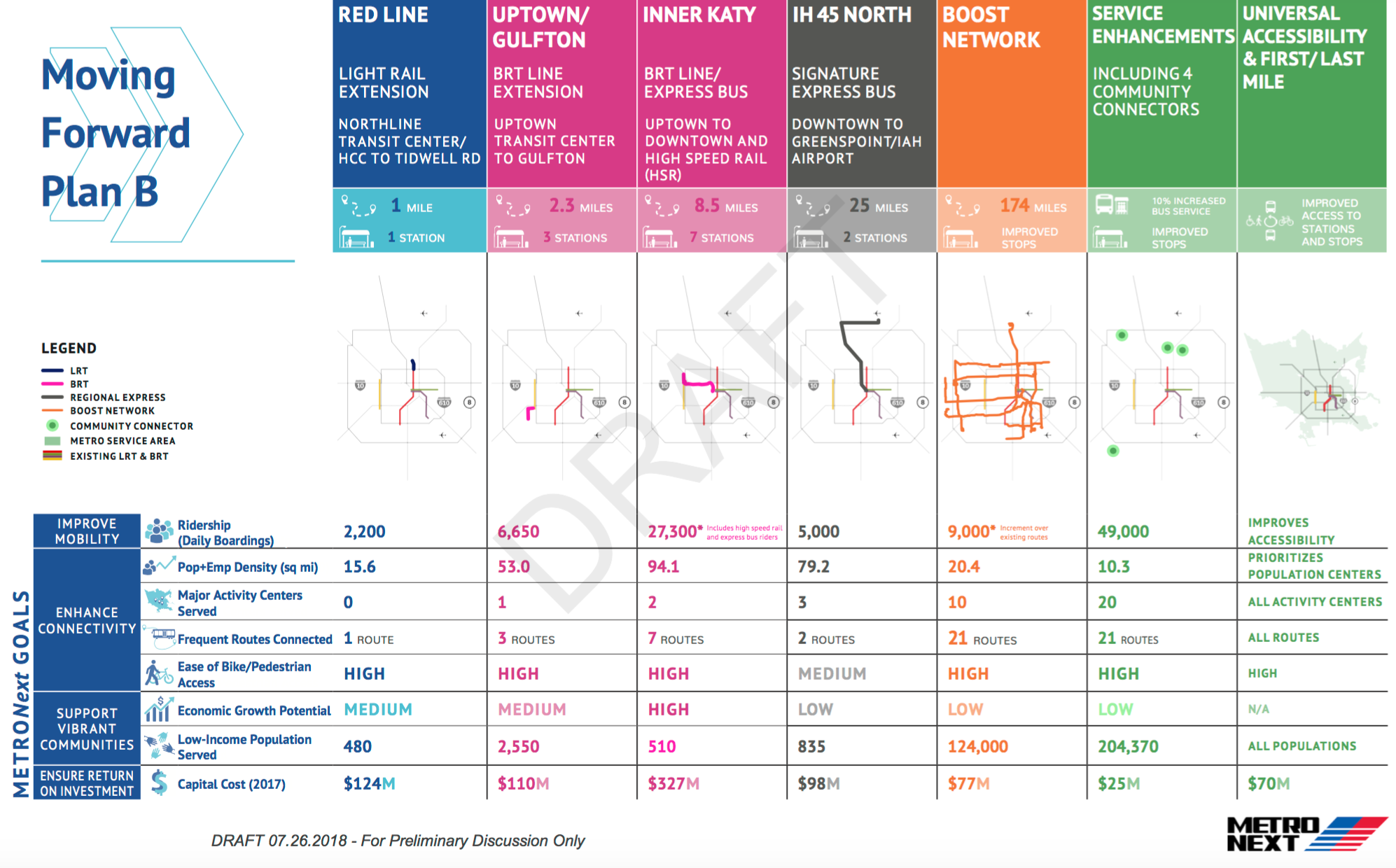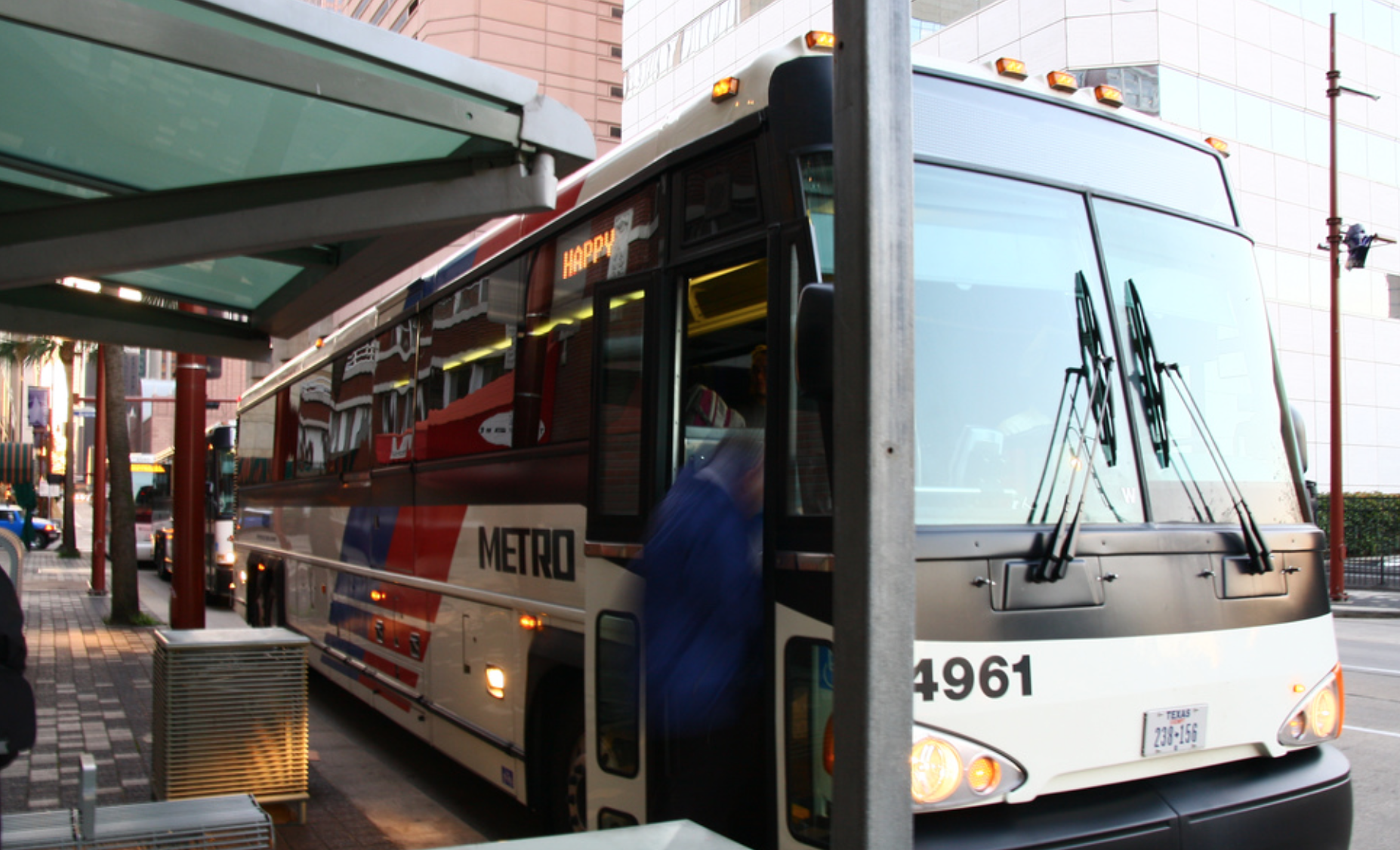In the dream scenario Houston's Metro transit agency presented to its board recently, hundreds of miles of new light rail, bus rapid transit and frequent local bus service are all included in a $35 billion vision that would increase the percentage of people within a half-mile of either light rail or bus rapid transit by 460 percent and would specifically increase the percentage of low-income households with access to those services by 440 percent.
But that vision is far from a reality. By the agency's estimations, it could afford somewhere between $1 billion to $2.8 billion of those projects. And that means compromises and possibly a bond referendum. Board chair Carrin Patman was careful to stress the agency would only propose bonds it could repay confidently. Regardless, the grand vision that would expand late-night service, create a regional two-way express network, offer rail connections to the airports and improve accessibility and bus shelter infrastructure, among other changes, is unlikely to be realized.
With this in mind, transit advocates have evaluated the two alternative draft plans presented by the agency alongside the larger vision. With so many details still uncertain given the plans' very preliminary nature, LINK Houston offered some high-level equity assessments of what's on the table in a release Friday.
Given the financial constraints facing the agency, LINK Houston noted the tension between appealing to new potential transit users, theoretically expanding needed political support for any bond referendums, and serving existing transit users. It's a common conversation for transit agencies and often divides along plans for commuter rail or services and improved local bus networks. "While the Board vocalized concern about voters interested in Park-and-Ride service, the reality is that 67 percent (or 185,278 trips) of METRO’s rides are on local buses," the statement notes.
There also needs to be better and more transparent research on who rides transit, including new or potential riders across the city and not only in the suburbs. Existing riders on local buses, who are equally important constituents, are spread throughout the city. A deeper understanding of current METRO riders and ridership should be made public and analyzed with consistency, not with overly optimistic projections that buck trends.
The transit agency's planners were unavailable for further comment Monday.
Houston is far from the only city thinking about questions of equity when it comes to transit.
"The way that transit agencies think about equity impact comes largely from federal transit administration guidance on the topic," explained Alex Karner, a community regional planning assistant professor at the University of Texas at Austin. "It involves comparing the population groups that are affected by a service change to the overall population in a service area."
It sounds simple but there are many choices agencies can make in assessing and presenting the data that can obscure what's really happening, explained Karner. Agencies could use Census data along a given route and compare it to population data for the overall system to see whether a change would have a disparate impact on potential riders of color, for example. Or agencies could use actual rider data to better understand who uses the service currently and thus would be affected.
Under the federal guidance, agencies can also offset any disparate impacts through changes elsewhere in the system to effectively balance out impacts on a larger scale. But here, too, explained Karner, the metrics aren't necessarily representative. Losing a bus route, for example, could be mitigated by marginally improving headways elsewhere even though the impacts are markedly different in magnitude.
"It's very easy for an agency to kind of get the output that they want," he said. In a recent TransitCenter report, the research and advocacy group noted that "typical transit agency equity policy consists of little more than the box-checking exercise required by federal “Title VI” regulation, which is designed to limit further harm to people of color—not to advance equity."
That's why taking the time to understand a plan's impacts are so critical.
"The staff clearly attempted to address social and geographic equity," LINK Houston wrote while acknowledging that financial constraints will alter what's possible.
Metro had 25 community meetings and 100 additional meetings with other groups and stakeholders, according to the agency. And the draft plans included more detailed breakdowns of who and what would be served by each element. So under Plan A, for example, the proposed bus rapid transit or express bus service connecting Inner Katy to downtown and high-speed rail would connect two activity centers, seven frequent routes and cost roughly $327 million. But the estimated low-income population served would only be 510 people. In comparison, the University Corridor bus rapid transit line connecting the Westchase Park and Ride all the way to Kashmere Gardens, with 34 stations along the way and with connecting service to Gulfton, would connect four major activity centers, 10 frequent routes and cost $1.16 billion. It would also serve an estimated 10,170 low-income people.
That robust bus rapid transit corridor is lost in Plan B, which instead just connects Gulton and the Uptown Transit Center and serves an estimated 2,550 low-income people.


The draft's breakdowns include other metrics, like the ease of bike and pedestrian access for each proposed element, the economic growth potential and the potential ridership.
The nod to activity centers is an important one, according to Karner, who is currently contracted with the Federal Transit Administration to evaluate agency equity practices across several case studies, including Houston. "One thing that I've been trying to push is instead of just looking at demographics, looking at access to opportunities," said Karner. "I think it's important because it's actually what transportation systems are for," he added, "We want to connect people to the things that they need to do."
There are other ways to think about transit that can give a more human read on a system's impacts. While Metro's presentation included impacts on low-income populations, it did not include breakdowns by race or by auto ownership, for example. However, that doesn't mean the agency doesn't have the data, since, like many large agencies, it has conducted on-board rider surveys. Assessments could include how many jobs are within a half-mile walk of a stop or libraries or daycares. Agencies could consider not just the typical rush-hour commuter, but the shift worker heading in to work in the late evening or the caregiver picking up kids after school. What happens to their service?
"There has to be some way to make the analysis kind of ring true," said Karner.
In its recent report, TransitCenter outlined a number of recommendations to support equity in transit that calls for agencies to think beyond transit alone. "Transit planning should account for housing affordability, and improve access to and from affordable housing," reads one of the recommendations. "Transit operations and capital projects should support employment in low-income communities and communities of color," reads another.
Those would mean large shifts for most agencies. LINK Houston notes the financial challenges facing Metro in its statement, writing "whether METRONext is an equitable approach to transportation comes down to what METRO can afford." One possible option to help improve funding: taxes. "Taxes are unpopular, yet maybe there’s some form of an airport tax that could support rail extensions to the airport," the release reads.
Though, a hike in taxes doesn't typically guarantee that every project is going to get completed. Atlanta's MARTA officials were able to get a $2.5 billion tax increase passed by residents in 2016, but with the money, officials still realize not everyone's transit wish list will be completed, since the total cost of the proposal is $11.5 billion.
"We are working very hard to get this right,” MARTA Board Chairman Robbie Ashe told The Atlanta Journal-Constitution. “But we realize that, at the end of the day, somebody’s likely to be disappointed.”
Metro's plans are still very preliminary and the board was clear that new technologies, potential partnerships, changes in financial projections and more could affect the final plan. Patman also stressed during the agency's presentation that modes presented in each plan were also subject to change.

